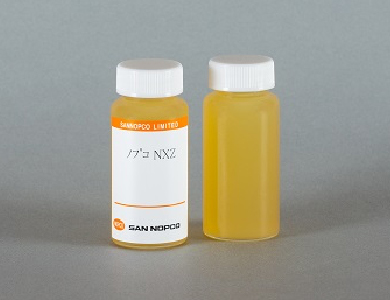PRODUCTS BY FUNCTION
-
FUNCTION.01Defoamers
- It is hard to imagine life without the foam found in everyday products like shampoos and washing detergents. However, in the industrial world, foam is a major source of trouble. These foam-related troubles are not limited to easily recognizable issues such as tank overflow; there are plenty of other problems not immediately seen as resulting from foam, such as poor dispersion of fillers, defects in coating, creation of scum, product separation, and inhibition of permeation and wetting. Two methods have been investigated for removing foam - the mechanical method (blasting, varying pressure, etc.) and the chemical method. The chemical method centers on defoamers, which are added in small quantities to solve manufacturers’ foaming troubles.
There are three types of defoaming actions: foam-breaking, foam-suppressing, and deaerating. In the first type (foam-breaking), foam is rapidly destroyed by adding an agent to a foamed liquid. In the second type (foam-suppressing), the agent is added to the liquid beforehand, thus restricting it from foaming. And in the third type (deaerating), foam from the liquid is merged into one big mass, accelerating its rising to the surface.
Foam is stabilized when a surface-active substance is disposed against a liquid interface. As the main component of the defoamer has a lower surface tension than the foam liquid, it allows the defoamer to penetrate through and break the foam film.
As it is important that the defoamer disperses within the foaming liquid at the particle size appropriate for the thickness of the foam film, our company combines core materials with defoaming components and surfactants, as seen in Fig. 2, to offer defoamers that are ideal for and compatible with the properties of our clients’ foam liquids.
Our Core Products
-
Defoaming
NOPCO NXZ Series
Metallic soap type defoamer

NOPCO NXZ is a metallic soap type anti-foaming agent with remarkable anti-foaming ability for emulsion and latex. It is especially functional with acrylic, vinyl acetate or vinyl acetate-acrylic emulsion. Due to its high anti-foaming ability, it has been highly acclaimed in Japan as well as in China and other countries.

Defoamers for Paint and Coating

Defoamer for paint and coatings is an additive that rapidly eliminates foam during paint application and contributes to achieving even coatings that are free from defects. However, it is also known to cause coating flaws such as popping, fisheyes, cratering, and depressions. It is extremely important, then, for defoamers for paint and coatings (ink) to both eliminate these defects while offering defoaming properties.
Our company’s product line-up features a wide variety of defoamers for aqueous and non-aqueous coatings and offers the most suitable solutions by adjusting additives according to the paint’s viscosity, its production process, the paint application process and the type of resin.
Additives for aqueous coatingAdditives for non-aqueous coating
Defoamers for Pulp and Paper

Defoamers are used within each process during the manufacturing of pulp and paper, from the washing of kraft pulp to papermaking, and coating.
A defoamer with a low generation of pitch is required for the kraft pulp washing process. Our defoamers (both the mineral oil and silicone types) are highly acclaimed for their low pitch and superior defoaming performance.
The defoamers used within the papermaking process are mainly higher alcohol types with excellent foam-removing properties and negligible influence on the size press as well as polyether types carrying excellent antifoaming properties.
Within the coating process, the balance between cratering and the defoaming property is just as important as the paint defoamer, which is why we select the ideal product based on the coating applicator and coating solution properties.
Agents for the manufacturing of kraft pulpAgents for coating and size pressAgents for papermaking and waste water processes
Defoamers for Emulsion and Latex

Emulsion and latex foam easily due to the large amount of surfactant they contain. To suppress foaming during each process, from manufacturing to the final product’s completion, we add a defoaming agent. Dispersibility is a very important characteristic of defoamers for emulsion and latex. If the dispersion property of the defoamer is insufficient, the defoamer’s lipophilic components will float to the surface of the emulsion/latex affecting the final product’s quality.
From the manufacturing of emulsion/latex (mainly the monomer-stripping process) to filling and transportation and the final coating process, our company offers a selection of the best products based on the resin type of the emulsion and latex.
Additives for the manufacturing of resin, rubber, emulsion, and latex
Defoamers for Ceramics
We add defoamer in order to suppress foam due to binder added to adjust aqueous slurry in ceramics manufacturing. To avoid affecting the special features of fine ceramics, electric and magnetic functions, we use an ash-free polyether type defoamer or a mineral oil type defoamer, having amide or wax as a core material.
Other Defoamers
Defoamers for wastewater treatment: We have defoamers ideal for foaming in aeration tanks and discharged water.
Defoamers for the fermentation process: We have defoamers ideal for foaming caused by fermentation.
Defoamers for papermaking: We have defoamers ideal for the white water during the production of papermaking board.
Agents for waste waterAgents for fermentationAdditives for the manufacturing of particle/siding boards

Fig1-1

Fig1-2

Fig1-3

Fig1-4

Fig1-5

Fig2



